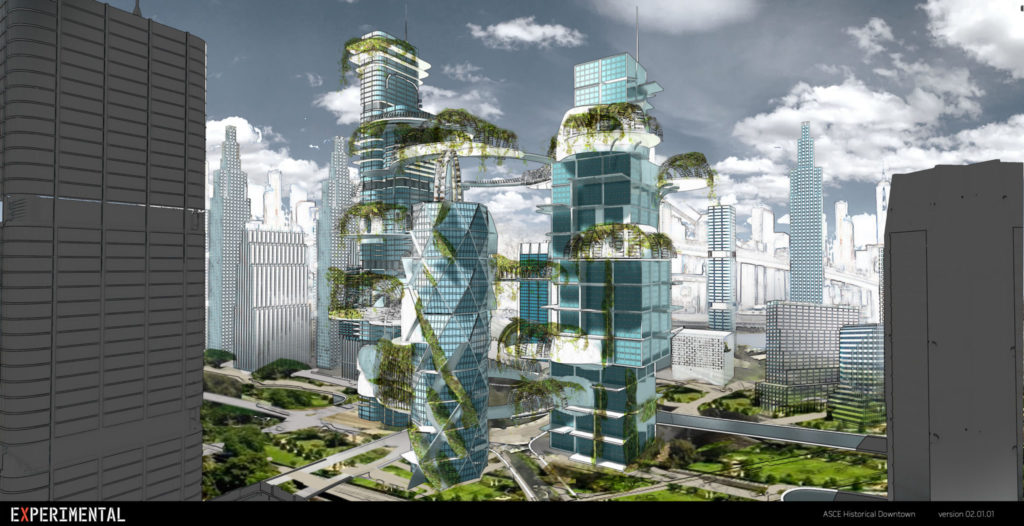
What will cities look like in 2070? The American Society of Civil Engineers imagines they could look like something out of a sci-fi movie, and it has partnered with a design studio that specializes in CGI world-building to create a visual simulation of the future built environment. ASCE hopes this visualization model, called Future World Vision, will inspire engineers and future engineers to explore the possibilities.
To prepare Future World Vision for public release early next year, the ASCE convened an advisory committee that included John W. van de Lindt, professor in Civil and Environmental Engineering, and Mehmet E. Ozbek, professor in Construction Management.
A committee member was chosen to represent most of ASCE’s technical institutes, covering disciplines such as architectural engineering, construction, transportation and structural engineering. Of the six committee members, two were from Colorado State University.
ASCE wanted a subject matter expert from each discipline to test the platform and give feedback to improve it. Ozbek and van de Lindt were the only academics on the committee otherwise populated by practicing engineers.
Hollywood meets engineering
ASCE hired L.A.-based Experimental to render its vision for the future. Experimental is known for its work on movies such as Minority Report, Man of Steel, and Charlie and the Chocolate Factory, as well as video games Beyond Blue and Never Alone.
Experimental brought ASCE’s vision of the future to life as an immersive environment with evocative visuals and narratives. Users will be able to interact with the virtual built environment, leave comments and start discussions with other users, and consider potential future infrastructure – some radically different than what exists today.
“Future World Vision is not attempting to predict the future,” said Jerry Buckwalter, ASCE chief innovation officer and chief architect behind Future World Vision. “We’re just trying to be provocative – to help us think differently about the quality of life and societal benefit of our future built environment.”
Future World Vision anticipates global changes in technology, climate, demographics and building materials. It incorporates alternative energy, smart infrastructure, autonomous vehicles and advanced materials that ASCE believes will be mainstream fifty years from now.
Users can experience the virtual worlds from a city-wide perspective down to the neighborhood level, so they can imagine how people will live in future environments.
The program envisions five archetypal communities: mega city, floating city, frozen city, rural city and off-planet city. Mega city, the first world to be built out, is a metropolis serving 50 million people that features vertical structures and transportation, green and social spaces, drone docking and recharging stations, and structural materials with biological functionality.
Future World Vision includes extensive public outreach built around an IMAX movie, museum exhibits and educational programs, all of which are under development.
Reality check
Van de Lindt, Ozbek and the rest of their committee were technical experts tasked to keep the project within the realm of reason.
“By the time they got to us, they were saying, ‘Is this possible?’ We said, it’s definitely forward-thinking and a bit out there, but we think this can work,” said van de Lindt, who chaired the ASCE Institutes Committee on Future World Vision. “It doesn’t have to be probable; it just has to be possible at this point.”
“The idea is gravity will still remain with us in 2070,” Ozbek joked.
For six months, van de Lindt and Ozbek met with the developers, made suggestions and provided resources, like research articles or contacts with relevant experience. Their input was incorporated into the project.
Users of the virtual platform can navigate their own path through the futuristic cities and click on various features for explanation. For example, a pop-up might describe a self-building structure or self-healing construction material.
These callouts are meant to spark conversation and multidisciplinary collaboration among engineers and professionals from other disciplines.
“If this is what the future’s going to look like, what do we need to do now to get there?” Ozbek said. “It’s going to help us make that future happen.”
Future World Vision doesn’t stop at the built environment; it delves into policy, sustainability, diversity and biosecurity, among other big-picture topics.
Inspiring future engineers
Buckwalter and ASCE hope Future World Vision will help transform civil engineers to be systems thinkers and collaborate across disciplines. They also want to entice tomorrow’s civil engineers.
“Part of our preparation of the next generation of civil engineers is to continue to be disciplined problem solvers, but also to show more creativity and imagination,” Buckwalter said. “The combination of rigorous engineering with innovative thinking will define the master designers and builders of the future.”
Ozbek and van de Lindt plan to apply Future World Vision in some of their classes. They expect high school students exposed to the program will become interested in pursuing engineering professions.
“As a recruiting tool, it will definitely have an impact on the overall profession by getting some of the best and brightest into civil engineering,” van de Lindt said.